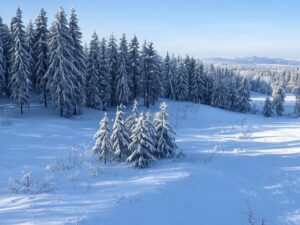Albedo: The Reflective Power of Surfaces and Its Impact on Climate
Meta Description
Albedo measures the reflectivity of a surface (like snow or asphalt). Discover how it influences global climate, glacier melt, and urban warming.
Introduction
Albedo is a key concept in climatology and meteorology that determines how much solar energy is reflected by a surface. From bright snow to dark asphalt, albedo affects Earth’s energy balance and plays a crucial role in climate change.
In this article, you’ll learn:
✔ What albedo is and how it’s measured
✔ Why snow has high albedo and oceans have low albedo
✔ How it influences local and global climate
✔ Practical examples (urban heat islands, polar feedback loops)
What Is Albedo?
Albedo (from the Latin albus, meaning “white”) is a surface’s ability to reflect solar radiation. It is expressed as a percentage or a value between 0 (total absorption) and 1 (total reflection).
Albedo Formula
Albedo=Reflected RadiationIncoming Radiation
Types of Albedo
- Surface Albedo – Reflectivity of a specific material (e.g., snow, forests, water).
- Planetary Albedo (Earth’s Albedo) – Global average reflectivity (~30%).
- Spectral Albedo – Varies by wavelength (e.g., ice reflects more visible light than infrared).
Examples of Albedo Values
| Surface | Albedo (Approx.) |
|---|---|
| Fresh snow | 0.80–0.90 (80–90%) |
| Sea ice | 0.50–0.70 |
| Sand desert | 0.40 |
| Forests | 0.10–0.20 |
| Asphalt | 0.05–0.10 |
| Ocean (low angle) | <0.10 |
Why Is Albedo Important?
1. Effect on Global Climate
- High-albedo surfaces (snow) cool the Earth by reflecting sunlight.
- Low-albedo surfaces (oceans) absorb heat, contributing to warming.
2. Ice-Albedo Feedback Loop
- Melting polar ice reduces albedo, exposing darker surfaces (ocean) that absorb more heat → accelerates warming.
3. Urban Heat Islands
- Cities with lots of asphalt (low albedo) are hotter than rural areas. Solutions: white roofs and parks.
4. Agriculture and Soil Management
- Crops like wheat (moderate albedo) can influence local temperature patterns.
How Is Albedo Measured?
- Satellites – Instruments like MODIS (NASA) and CERES measure Earth’s reflectivity.
- Pyranometers – Ground devices that compare incoming and reflected radiation.
- Multispectral Imaging – Used in vegetation and snow studies.
Climate Change and Albedo: A Dangerous Relationship
- Arctic ice loss: Reduces global albedo, speeding up warming.
- Deforestation: Replaces forests (low albedo) with grasslands/crops (higher albedo) but releases CO₂.
- Proposed geoengineering: Increasing albedo with orbital mirrors or artificial clouds (controversial).
Fun Facts
- The Moon has an albedo of ~0.12 (very low; it looks bright only against the dark sky).
- Enceladus (Saturn’s moon) has the highest albedo in the solar system (~0.99) due to its icy surface.
Key Takeaways
✅ Albedo defines how much sunlight a surface reflects.
✅ Snow and ice have high albedo; oceans and asphalt have low albedo.
✅ It plays a critical role in climate and global warming.
✅ Measured via satellites, sensors, and climate models.
FAQ
Q: Can we modify albedo to fight climate change?
A: Yes, but with risks. Painting roofs white helps locally, but global techniques (like aerosol injection) are controversial.
Q: Why does water have low albedo if it looks reflective?
A: It reflects strongly only at low angles (e.g., sunset). Normally, it absorbs ~90% of light.
Q: How does pollution affect albedo?
A: Soot on snow (from wildfires or industry) lowers its albedo, speeding up melting.

 Español
Español
 Nederlands
Nederlands
 Deutsch
Deutsch

